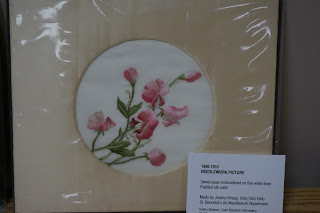Didn't you just love the embroideries from my last post? The work these women did just amazes me!
There were two sisters who were instrumental in the development of the Art and Needlework Department.
At the young age of 13, the first sister, Willibalda Scherbauer, received a scholarship from King Ludwig to learn embroidery. This was quite an honor. She later graduated from the Royal Art School in Munich. As you might suspect, this love of embroidery carried through when she found her way to St. Joseph!
The second sister who was instrumental in the development of the embroideries was Justina Knapp. She wrote a book, Christian Symbols and How to Use Them, that is still available on Amazon. She worked for 60 years in the ecclesiastical art department and was instrumental in obtaining over 500 volumes for the library. Many of these books are out of print.
One of her rules for the sisters who were embroidering was they must take a break every 45 minutes and set their eyes upon something else. She also brought in guests who would teach on various topics such as color. She understood that these embroideries were works of art, an expression of their love for God. She was named one of six women who most influenced artistic development in the state of Minnesota!
There is a nice article about the embroideries and Justina Knapp at this link. Scroll down in the PDF file to pages 8-13.
In addition to the ecclesiastical pieces, the sisters also embroidered for friends and family. Below are several examples. Be sure to click on them to get them full screen, and then click again to enlarge the photo so you can see the detail.
Don't you agree that they are lovely? One of the sisters told us that sometimes these were given to people who would see their lovely work and provide more embroidery materials for the sisters. Wonder if that would work for us today?
I still have more to show you so expect one more post on our trip!
Friday, June 28, 2013
Saturday, June 15, 2013
Visit to St. Benedict's Monastery
Today our EGA (Embroiderers' Guild of America) chapter took a field trip to the St. Benedict's Monastery in St. Joseph, Minnesota. What a treat! Upon our arrival we were warmly greeted by the sisters who had set out fruit, sweet bread and coffee for us. There were four vestments on display in the room where we were to hear Sister Moira tell us a little about the history of the embroideries stitched at St. Benedict's. This is one of them:
This was just a teaser for what was to come! But first, some background... Sister Moira told us that this order originated in Bavaria. They came to this country in 1852 and made their way to St. Joseph, Minnesota in 1863. In 1867 the Art and Needlework Department was established. St. Walburg Hall was built specially for doing needlework.
The sisters would take orders for liturgical pieces. They had a catalog of possible designs, but all items were made to order. There were as many as 18-20 sisters working in the Art and Needlework Department. They used quality materials, silk and gold threads and fine brocades. At the time these materials were not available in the US so had to be obtained from Europe. Sadly, the department was closed in 1968.
There were two people who were instrumental in the needlework efforts of the sisters, but more on that in my next post. For now, let's go back into the inner room!
One of the pieces that I was taken with was the ciborium cover. Look closely at the intricate detail of the stags. And notice the background of chain stitches. They loop over one another and create an intricate background all from a simple chain stitch.
Another favorite was this piece with the angels. The shading on the wings is incredible. And do you see what is at the top of the wings? The backs of the angel heads! Each strand of hair carefully embroidered. Just lovely!
This was truly a special day for our group and I have much more to show you in my next post! So, until then...
This was just a teaser for what was to come! But first, some background... Sister Moira told us that this order originated in Bavaria. They came to this country in 1852 and made their way to St. Joseph, Minnesota in 1863. In 1867 the Art and Needlework Department was established. St. Walburg Hall was built specially for doing needlework.
The sisters would take orders for liturgical pieces. They had a catalog of possible designs, but all items were made to order. There were as many as 18-20 sisters working in the Art and Needlework Department. They used quality materials, silk and gold threads and fine brocades. At the time these materials were not available in the US so had to be obtained from Europe. Sadly, the department was closed in 1968.
There were two people who were instrumental in the needlework efforts of the sisters, but more on that in my next post. For now, let's go back into the inner room!
One of the pieces that I was taken with was the ciborium cover. Look closely at the intricate detail of the stags. And notice the background of chain stitches. They loop over one another and create an intricate background all from a simple chain stitch.
Another favorite was this piece with the angels. The shading on the wings is incredible. And do you see what is at the top of the wings? The backs of the angel heads! Each strand of hair carefully embroidered. Just lovely!
This was truly a special day for our group and I have much more to show you in my next post! So, until then...
Subscribe to:
Posts (Atom)











